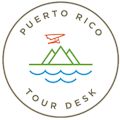Puerto Rico’s other coast: ‘An easier life’

GUANICA, PUERTO RICO — The three-mile trail to the abandoned fort on top of this dry forest seems easy enough to tackle.
A clear path to the “Fuerte” lies ahead, surrounded by shrubs and cacti, vegetation you would not expect to find on a tropical island.
But this is a dry forest, one that gets only about 30 inches of rain per year vs. about 200 in the rainforest on the other side of the island.
When I pull into the parking lot, there’s a park ranger station, but no park ranger in sight. I hike alone. Birds whizz by. Butterflies flutter.
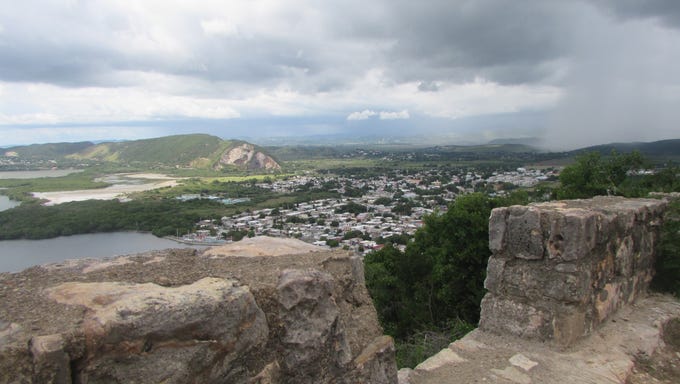
I’m taking a road trip on the west coast of Puerto Rico, also known as the Porta del Sol, or gate of the sun. I choose Puerto Rico because it’s so easy to get to. Americans don’t need passports to travel here. Several airlines, including JetBlue Airways, have reasonably priced non-stop flights from various cities to San Juan.
But on the advice of a Puerto Rican friend, I decide to skip the crowded capital and drive three hours to the less crowded west coast to explore the tranquil beaches and charming towns.
“The southwest coast of Puerto Rico is a spectacular area of beaches still very little known by tourists,” my friend Samuel Rodriguez, a native of Puerto Rico who now lives in Virginia, tells me. “You will find mostly laid-back locals and surfers only within miles of uncrowded pristine beaches.”
LOVE HIKING? The Caribbean’s most scenic hikes
After an hour of hiking uphill under the beating sun, I arrive at the Fuerte. Before me is a panoramic view of those pristine beaches. The fort itself is now covered in graffiti but is still a beautiful structure. For about 30 minutes, I have the whole place to myself.
Then John and Maureen Alvarez appear.
They too are taking a road trip. They live in Lafayette, Calif., but John was born in Puerto Rico. He’s taking Maureen, his wife, on a tour of his childhood stomping grounds. Like me, they’ve chosen to stay away from San Juan and follow a more uncharted path.
“This is pretty remote,” John says. “It’s really hard to find. This part of the island is pretty much undiscovered.”
DISCOVERING THE UNDISCOVERED
Stop by a beach shack for an afternoon snack in the town of Rincon, and you may end up getting a salsa lesson from Rey Chacon.
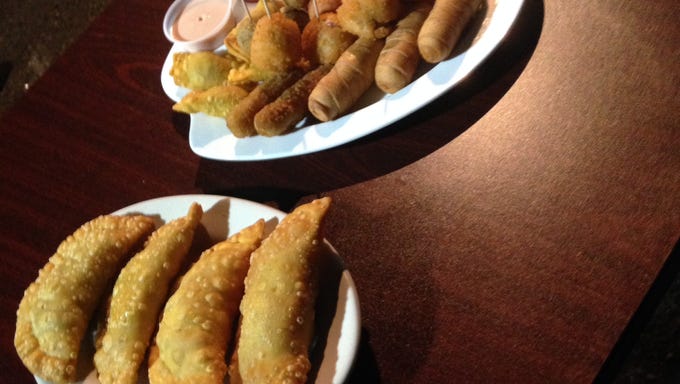
On a Tuesday afternoon, my friend Kristie Kellahan and I pull into the Cafeteria El Balneario in search of empanadillas,or fried turnovers, and Medalla, the local beer.
Rey, which in Spanish means King, is also at the shack drinking beer—and the occasional shot of rum. He wears a straw hat and dances alone to salsa tunes pounding from a boombox.
He offers us a salsa lesson. Kristie obliges him.
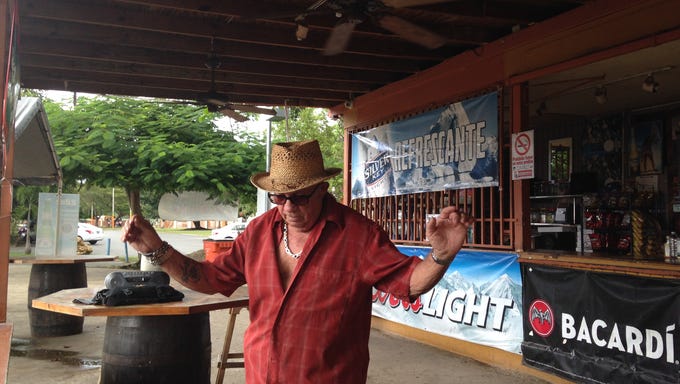
“You come here on a Sunday afternoon, and people are singing karaoke,” Rey tells us.
On this particular afternoon, Rey Chacon is our only entertainment.
After our impromptu salsa lesson, we head south to explore the other beaches lining the southwest coast.
We arrive at Boqueron in the town of Cabo Rojo. For $4.28—the price to park—we get access to a beach with white sand and crystal clear turquoise water.
We count the number of people there. Only three others are in the water.
“It’s beautiful here. It’s my favorite area,” says Elle Perez, a New York City student visiting her grandmother.
According to local legend, Puerto Rico’s most famous pirate Roberto Cofresi hid treasure in a cave south of Boqueron Bay.
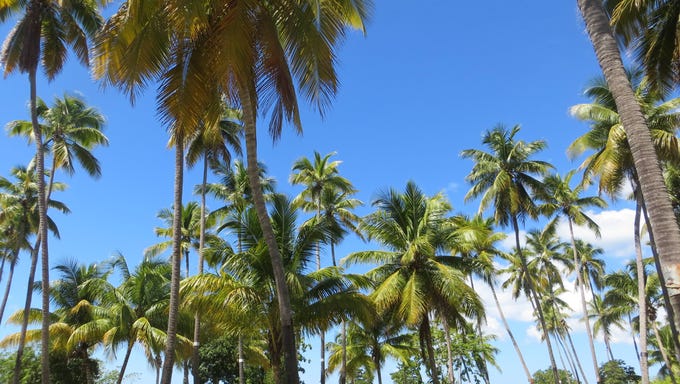
No one has found the hidden treasure. But in my opinion, the beach itself is the hidden treasure.
After a swim in the calm warm water, we pack up and drive farther south to Combate Beach.
It’s lunchtime and Annie’s Place, a restaurant on the water, is filling up with people drinking beer and eating mofongo, a traditional dish of mashed plantains with fish or meat mixed in.
“No shirt, no shoes, no problem,” a sign at the bar says.
After lunch, we stroll down the long narrow beach. We have a lot more company on this beach, but it is still tranquil.
Next, we go to a place commonly known as Playa Sucia, or dirty beach in Spanish. The beach’s official name is La Playuela, and there is nothing dirty about it.
Getting there takes effort. We drive down an unpaved road. Along the way we see post-apocalyptic looking salt flats. At the end of the road, we come across a parking lot. From there, we follow a walking path past the salt flats. Within minutes, the magnificent Caribbean is before us.
Playa Sucia is located within the Cabo Rojo National Wildlife Refuge, which helps make it quiet and pristine.
To the right, the Los Morrillos lighthouse hovers over the sea on a hill.
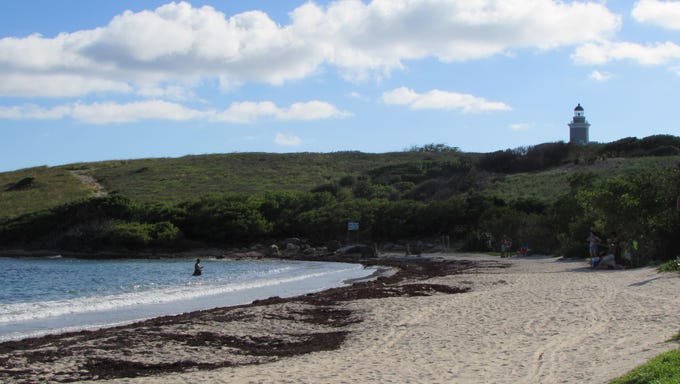
We’re told the views from the lighthouse are magnificent. Unfortunately, when we try to climb up there, a police officer tells us that it is closed. Never mind that the sign says it is supposed to close at 4:30 p.m., an hour later. Closing times—just like shirts and shoes—are mere suggestions here.
MORE PUERTO RICO: The island’s best beaches
AFTER SUNSET
In the evening, we take a sunset cruise off the fishing village of La Parguera in the town of Lajas.
Our captain, Nayib Torres of Johnny’s Boats, takes us to an island where iguanas live. We get close enough to spot a couple.
We pass houses built on stilts in the water. They are painted in yellows, oranges, pinks, and other Caribbean hues.
The sun sets over the water, setting off another explosion of colors. There’s hardly any wind. We coast around the mangroves. “I love the wind when it’s like this,” Torres says.
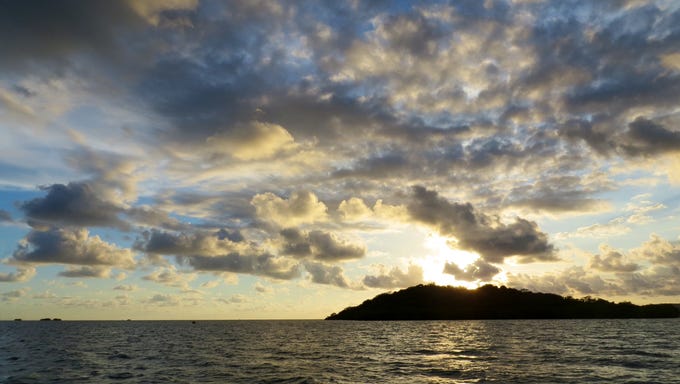
Once it’s dark, we get on another one of Johnny’s Boats to take a tour of the bioluminescent bay. There are three in Puerto Rico. Each night, the water glows because of the millions of microscopic organisms inhabiting it.
I expect a light show. But on this particular night, the moon and the stars are too bright.
A few people on our boat jump into the water. Kristie and I choose to stay on the boat and watch. I see a bit of a glow when the swimmers flap their arms.
“They’re all over me. That was crazy,” Erika Springman says as she climbs back in.
I can’t spot anything on her. The stars are far more impressive. “It’s not Cirque du Soleil,” Kristie says.
On another evening, we opt to stay on land and do some bar-hopping. Chinchorros, or casual bars that also serve food, are quite popular across the island.
It’s Tuesday, and La Naza nightclub in the town of Mayaguez is so crowded that people are dancing salsa on the street.
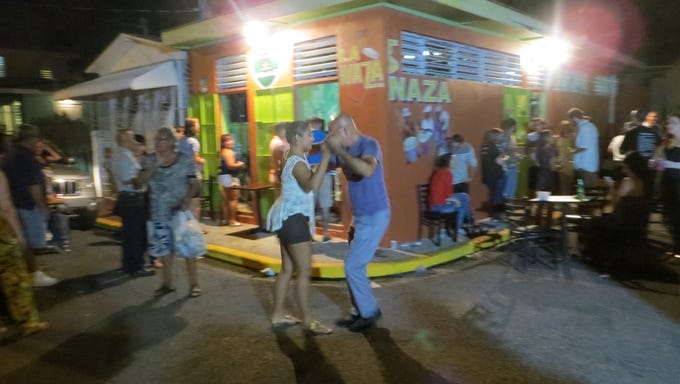
A live band is playing inside. People are snacking on empanadillas. Beer and rum is flowing freely.
It’s nearly 11 p.m. but no one seems concerned about getting to bed or having to wake up early the next day.
“It’s more relaxed here,” says Pamela Penchie, who works in public relations.
This is the kind of town where you’re just as likely to see a Volkswagen Beetle as a horse strolling down the street, where people give directions by giving you landmarks rather than addresses, and where strangers happily share their rum with you.
“The west side,” she says, “is an easier life.”
by Nancy Trejos, USA TODAY
